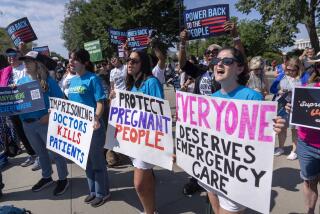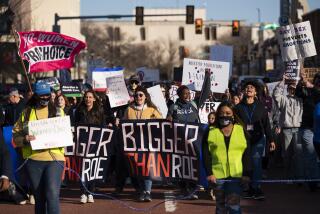Supreme Court Case Puts Right to Abortion on Trial : Law: Ruling on the Pennsylvania statute could impose new curbs or even end the Roe vs. Wade standard.
- Share via
WASHINGTON — In one of the most intensely watched abortion cases in nearly two decades, the Supreme Court will consider Wednesday whether to adopt a new legal standard that would once again permit states to make most abortions a crime.
The justices will hear arguments in a Pennsylvania case in which the state is seeking to enforce a law that places restrictions on a woman’s right to abortion, including one requirement that she notify her husband and another that she observe a 24-hour waiting period.
Attorneys on both sides of the case concede that the court is nearly certain to uphold the law. More important, they say, is the language it uses to do so: A narrowly written opinion would allow the Pennsylvania law to stand but leave other state restrictions in doubt. A more expansive ruling would allow states to outlaw abortion in all but extreme situations.
The Bush Administration, which is intervening in the case as a friend of the court, is urging the justices to take the more aggressive approach and declare that states have broad powers to prohibit abortion.
“The protection of human life--in and out of the womb--is certainly the most compelling interest that a state can advance,” Solicitor General Kenneth W. Starr said in a brief already filed with the court. “In our view, a state’s interest in protecting fetal life throughout pregnancy, as a general matter, outweighs a woman’s liberty interest in an abortion.”
The Administration wants the court to back away from its statement in the landmark Roe vs. Wade ruling of 1973 that abortion is a “fundamental constitutional right,” and to begin upholding any state restrictions on abortion that appear to have a “rational basis.”
Several states, including Utah and Louisiana, are awaiting the outcome of the Pennsylvania case to determine whether more restrictive laws that declare most elective abortions to be a crime will be allowed to stand.
“If they agree abortion is no longer a ‘fundamental right’ and the court adopts the ‘rational basis’ test, then laws like Utah’s and Louisiana’s will be upheld,” said James Bopp Jr., general counsel of the National Right to Life Committee. “Whether they say it or not, Roe vs. Wade will be gone.”
Kathryn Kolbert, an American Civil Liberties Union lawyer who has fought the Pennsylvania law, essentially agrees. “The court is likely to use this case to abolish the fundamental constitutional rights to abortion,” she said.
Starr, who will argue the Administration position before the court this week, is likely to find a receptive audience.
In the 1989 case of Webster vs. Reproductive Health Services, four of the nine justices signed opinions that would give the states legal authority to ban abortion. Among them was Chief Justice William H. Rehnquist, who disavowed the “fundamental right” standard and said that state laws should be upheld if they are “reasonably designed” to “further the state’s interest in protecting potential human life.”
According to Starr, it is “critical” that a majority adopt this standard in the Pennsylvania case. This is “not merely a lawyer’s quibble over words,” he said, but rather, it will govern how the judges evaluate pending measures that outlaw abortion.
Under the legal standard proposed by Rehnquist and the Administration, any state law prohibiting abortion could stand as long as an exception is made for a woman whose life is endangered because of her pregnancy.
In 1989, Rehnquist fell one vote short of a majority for this standard. Justice Sandra Day O’Connor refused to sign his opinion; as a result, the court failed to adopt a new rule of law.
Since then, however, President Bush has added two appointees to the court: Justices David H. Souter and Clarence Thomas. Should one or both agree with the chief justice and the three other justices who joined his 1989 opinion, a majority would be formed that would set a new legal standard on abortion.
On Wednesday, the justices will hear a one-hour argument from attorneys on both sides of the Pennsylvania case (Planned Parenthood vs. Casey, 91-744). On Friday, they will vote on the outcome of the case behind closed doors and then begin writing opinions. The decision is likely to be issued in the last days of June.
Lawyers who closely follow the abortion debate said the case offers the court at least four options:
--Uphold the Pennsylvania law in a brief opinion that does not say how more severe abortion restrictions will be analyzed. This option may prove attractive in an election year, although it would leave the law confused. But attorneys noted that the court will be hard-pressed to explain why regulations that were once struck down are now constitutional without setting forth a new approach to abortion.
--Disavow the court’s earlier declaration that abortion is a “fundamental right” in a majority opinion and instead say states may adopt reasonable laws intended to “further the state’s interest in protecting potential human life,” as stated by Rehnquist. For lawyers, these are code words for ending the constitutional protection for abortion, whether or not the court explicitly announces that it has overruled Roe vs. Wade.
--Adopt a moderate “undue burden” standard urged by O’Connor. In earlier comments, she has said the court should permit regulation of abortion but strike down measures that put “an undue burden” or an “absolute obstacle” before a woman seeking to end her pregnancy. The appeals court in the Pennsylvania case adopted this middle-ground position.
--Explicitly overrule Roe vs. Wade. Justice Antonin Scalia advocated this direct approach in 1989. Rehnquist and Justice Byron R. White said they favored such a course in 1986. Aides and friends to Thomas and Justice Anthony M. Kennedy believe that they may well join a Scalia move to explicitly overturn the Roe vs. Wade decision this year.
In recent interviews, lawyers who filed briefs in the case said they expect the court to follow either the first or second option. None expect the court to adopt O’Connor’s moderate position, which would allow some restrictions but not a state ban. Few expect the court to announce this year that it has overruled Roe vs. Wade.
Utah state attorney Mary Anne Wood said she is optimistic that the justices will use the Pennsylvania case to adopt the “rational basis” test for abortion. Under this legal standard, the courts uphold any law or restriction that appears to have a valid reason behind it.
Utah’s law, for example, would make abortion a crime except in cases in which the mother’s life or health is in danger, in which her pregnancy resulted from rape or incest or in which the fetus was found to suffer “grave defects.” These exceptions account for fewer than 10% of current abortions, attorneys said.
On April 10, a federal judge in Salt Lake City announced that he will rule on the constitutionality of the Utah law after the Supreme Court hands down its decision in the Pennsylvania case. His ruling will be governed by the legal standard adopted by the justices.
“I think they will adopt the ‘rational basis’ standard,” said Wood, who is defending the state law in Salt Lake City. “And if they do that, our law will stand.”
New York University law professor Sylvia Law, who filed a brief in support of the right to abortion, said she is less certain the Supreme Court will make a clear pronouncement in the Pennsylvania case. But she said she expects such a decision will come soon.
“The bottom line is they will uphold a prohibition on abortion. It is only a question of whether they will do it quickly in this case, or wait till next year for the next case,” she said.
No one questions that the Rehnquist court will adopt a legal standard on abortion that differs substantially from the standard that prevailed from 1973 to 1986.
In Roe vs. Wade, the court majority labeled abortion a fundamental right protected by the Constitution, akin to the right to vote or the right to freedom of speech. The Supreme Court gives its greatest protection to the exercise of fundamental rights.
In everyday terms, Americans may be said to possess all sorts of rights, such as a right to cross the street. But the government can restrict that right any time it has a good reason, or “rational basis,” for doing so. For example, crossing a freeway on foot can be made illegal because of the obvious danger to pedestrians. No one could successfully challenge such a restriction as a violation of his rights.
But a fundamental right protected by the Constitution is quite another matter. The high court has said the government may not infringe on such a right, except when the state has a “compelling” reason for doing so.
In Roe vs. Wade and the abortion cases that followed it, the high court not only labeled abortion a fundamental right but said the state’s only compelling interest in this area is the protection of a mother’s life and health. The fetus was deemed to have no rights until the point of viability, usually after seven months of pregnancy.
Under this legal framework, states had virtually no power to limit abortion, nor even to discourage the practice. There was only one major exception: States could refuse to subsidize abortion, the court said.
Today, only two members of the court--Justices Harry A. Blackmun and John Paul Stevens--continue to staunchly support the fundamental right to abortion as set forth in Roe vs. Wade.
Because five justices failed to agree on a new standard for abortion in the Webster case, lower court judges have been confused. Can a state place merely minor limits on abortion, such as a 24-hour waiting period? Or can it ban the practice entirely?
The trial judge in the Pennsylvania case ruled in 1990 that the law on abortion had not changed at all because the full Supreme Court had not announced a new standard. Based on that reasoning, Judge Daniel H. Huyett struck down the new Pennsylvania restrictions.
An appeals court in Philadelphia took a different view. The three-judge panel adopted the moderate position set forth by O’Connor. Based on that rationale, it upheld most of the Pennsylvania regulations.
Still other judges have said Roe vs. Wade has been implicitly overturned and, therefore, that even a total ban on abortion could stand.
When the Pennsylvania case was appealed to the Supreme Court, lawyers for the ACLU and the Planned Parenthood Federation sought to dramatize its impact. Rather than follow the normal route of asking the court to rule on the specific provisions of the state law, the ACLU asked the justices to issue a ruling on whether Roe vs. Wade remains the law.
They refused and instead issued an order agreeing to rule on the constitutionality of the various provisions of the Pennsylvania statute. Some legal experts said this move signaled that the court would rule narrowly in the case and avoid a sweeping pronouncement on the abortion issue. But most attorneys agree that the court retains the prerogative to rule broadly.
“I think it is wrong to read too much into that. To me, it just says they don’t want to play a political game. They want to answer a legal question,” said Catholic University law professor Robert A. Destro. “What counts is how they answer the question, what legal standard they set.”
More to Read
Get the L.A. Times Politics newsletter
Deeply reported insights into legislation, politics and policy from Sacramento, Washington and beyond. In your inbox twice per week.
You may occasionally receive promotional content from the Los Angeles Times.











